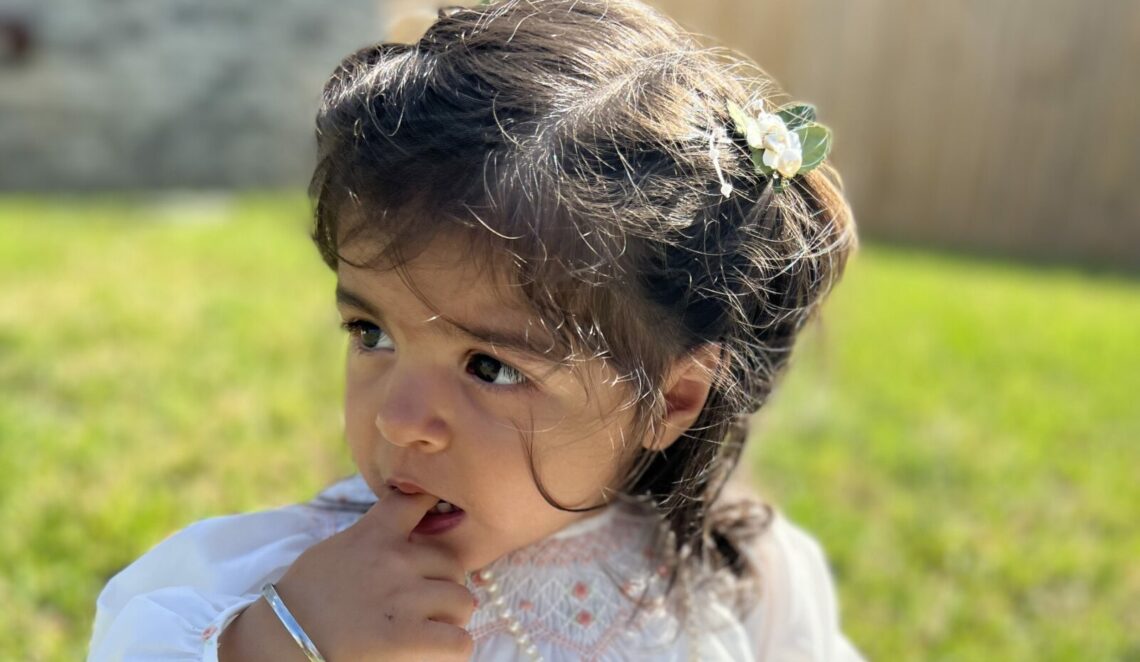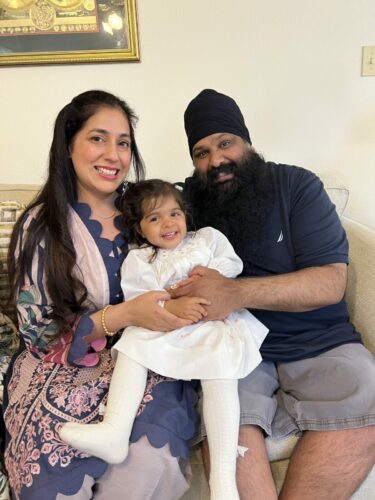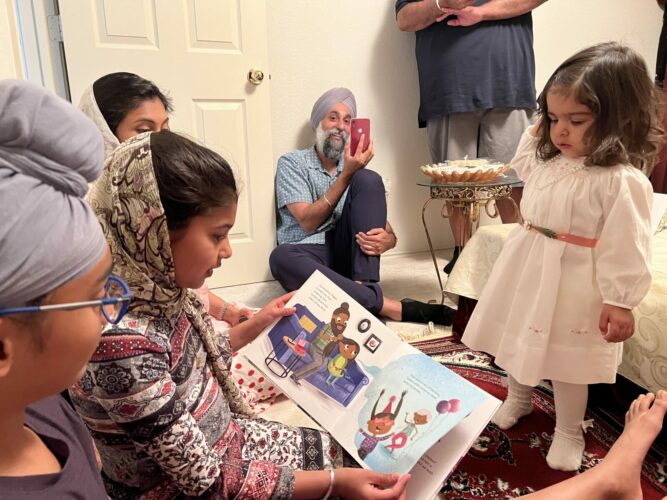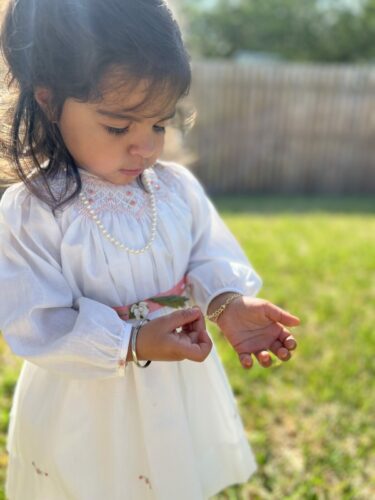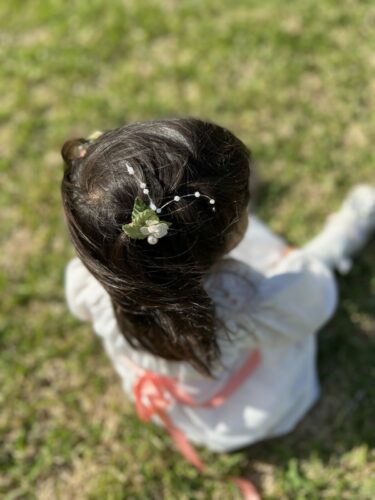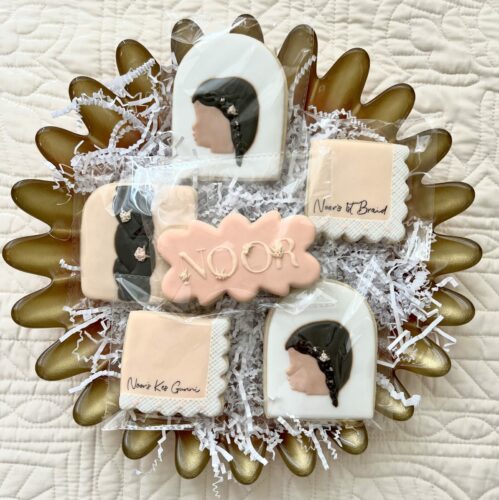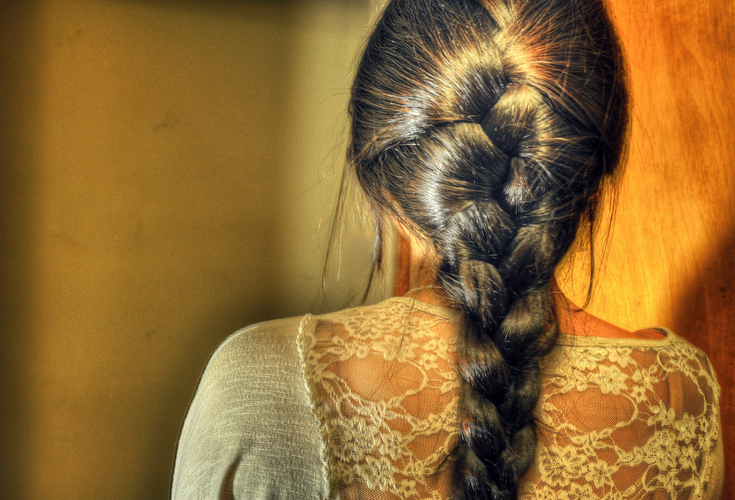Gathering their family around Guru Sahib, Manbeena Kaur and Gurinder Singh celebrated their daughter Noor’s kes and her connection to Sikhi with a Kes Gunni ceremony.
Ceremonies in Sikhi are Guru-centered and serve the purpose of facilitating a deeper connection between an individual, the Guru, Sikhi, and their sangat, while also rooting them in their identity. There are a few ceremonies many of us are familiar with such as Naam Karan (naming ceremony), Amrit Sanchar (accepting Khande de Pahul), Anand Karaj (wedding), and Atnam Sanskar (funeral rites). Starting to gain more attention are Dastar Bandi (the first time a Sikh – Singh or Kaur – dons the dastar), and Charni Lagna (where a Sikh formally begins reading from Guru Granth Sahib). Even rarer is the Kes Gunni (tying of the hair). In fact, the first we had heard of it was when Kaur Life reader, Manbeena Kaur Anand posted about it on her Instagram.
Due to its rarity and lack of available information, this may or may not be a Sikh ceremony but perhaps a regional, family, or village-based tradition. Please write in and let us know if you have any information regarding the Kes Gunni ceremony at hello@kaurlife.org .
“Everyone has heard of a boy’s Dastar Bandi, but we never really take the time to celebrate a girl’s kes, the significance of it, and the beginning of her relationship with Sikhi,” Manbeena Kaur shared in an Instagram post. “So even before I had Noor, I knew I wanted to do a Kes Gunni if I ever had a daughter.”
According to Manbeena and the women in her family, a Kes Gunni is the first time a girl’s hair is long enough to run a comb through and gather it together. She shared that she could not find much information beyond this. “I asked some of my friends, family members, did Google searches,” shared Manbeena, “but I couldn’t find much other than anecdotes.”
One community member said she had heard of Kes Gunni though never witnessed one. “I heard that some Sikhs in India had started to adopt the Hindu ceremony of Mundan where the baby’s hair is shaved off. So in response, Sikh elders said that we should be celebrating the baby’s kesh and encouraged Kes Gunni ceremonies instead.”
Celebrating Singhs’ Relationship With Guru Sahib More Than Kaurs’ Relationship
Manbeena shared that part of the inspiration for a Kes Gunni was to inspire a love for Sikhi in her daughter but to also balance out the gender disparity in how our community celebrates Sikhi within individuals. “In our community, Dastar Bandis are given a lot of importance and gravity. It just feels like the same is not done for our girls.”
“Growing up, I remember being invited to friends’ Dastar Bandis, and I was intrigued by it because our family didn’t do it,” Manbeena shared. “My mom explained to me that it’s kind of like a coming-of-age ceremony for Sikh boys but it’s also a special moment between him and Guru Sahib, because he is saying, ‘I’m going to carry your Saroop.’ There is a reason that the ceremony itself is done in front of the Guru and with your closest family and friends – your chosen sangat. They are not only there to celebrate with you on the day itself, but also to support you as you continue on this journey as the Guru’s Sikh .”
When Manbeena asked if there was anything for girls*, her mom said there’s a “Kes Guni” but Manbeena had never seen one before. “I had this conversation with my mom a while ago and I guess I had kept it in the back of my mind as a nice way to celebrate my daughter in the future, if I ever had one.”
Noor’s Kes Gunni
Manbeena didn’t know she was going to give birth to a girl or boy so, Noor was a surprise for both her and her husband, Gurinder. When Noor started getting older, and her hair started growing longer, Manbeena did what many “Girl Moms” do – run out and buy all kinds of rubber bands, hair clips, bows, etc. in all colors. But her first braid? Manbeena wanted to save that for the Kes Gunni. Gurinder, was completely supportive: “He’s obsessed with Noor. So anything that involves Noor, celebrating her, and especially starting her relationship with Sikhi, he’s up front and center.”
Since Manbeena couldn’t find any information on what a Kes Guni entailed, she developed the ceremony specifics herself.
“It was really important to me that the family played a role in the ceremony so it was a special, fun, and memorable occasion for everyone. My dad sang the shabad, ਅਵਲਿ ਅਲਹ ਨੂਰੁ ਉਪਾਇਆ ਕੁਦਰਤਿ ਕੇ ਸਭ ਬੰਦੇ ॥ Aval alah nūr upā▫i▫ā kuḏraṯ ke sabẖ banḏe, (Ang 1349). It was important for me to have her cousins involved in the ceremony; they recited 5 Parui from Jap Ji Sahib and read her favorite books ‘Hair Twins’, ‘My First Kaur Book’ and ‘Dream Big Little Kaur’. Her mami ji braided her hair for the first time in a beautiful French Braid on one side, and I made her some flower pins for the occasion. Then, I read her a letter I had written for her and gave her a gold bracelet with a comb charm. I am hoping to add more charms to mark her future special occasions. My mom read the vaak and my brother did the ardas. My in-laws and other family members joined via Facetime so they could take part in the ceremony as well.”
“Finally, I gave her cousins some gifts to remember the occasion and this time that we came together as a family. I got the kids some gifts that celebrated their kes – my younger nieces love unicorns and ice cream so I got them unicorns and ice cream hair clips, my nephew is super into Star Wars so I had rumalas made with that fabric, and my older niece loves Harry Potter so I got her Harry Potter hair accessories. I wanted them to have something special from Noor to remember this moment.”
Reactions & Responses
Two years old at the time, Noor thoroughly enjoyed the ceremony. “She’s an observer,” said Manbeena. “She loves new things, and she loves being with family. With everybody in the same room hanging out with her, talking to her, giving her attention, reading her her favorite books, feeding her parsad – she was on cloud nine.”
Immediately after the ceremony, Manbeena said she felt relief and accomplishment. “I felt, ‘Finally! Finally, I can braid her hair!’ because I had been saving it for the Kes Gunni. I know that sounds weird. Growing up, I always had my hair in a braid, and when I went to gurdwara or camps, that’s when I would see other girls like me – with their long braids down their backs. I guess that’s one of the ways I connected my appearance with being a Sikh, carrying this uniform, being a part of this community. And now, finally, my daughter gets to be one of those girls.”
Manbeena believes every parent can celebrate their children in whichever way they wish. The Kes Gunni was just one way she and Gurinder chose to celebrate Noor and their Sikhi. Ultimately, her desire is for this article to encourage more frequent and open talks within families about Sikhi. “I hope our story spurs some conversations in our community about celebrating our girls as much as we do our boys, but also conversations about what Sikhi means to each person. I hope families have dialogue with their kids about their Sikhi, saroop, kes and its significance and role in their lives. Our wish for our own daughter is that she knows that she has the ability to find love, strength, and support within Sikhi. Hopefully, with her Kes Gunni, she’s taking that first step towards understanding that.”
By Lakhpreet Kaur
*Dastar Bandi – While commonly done for boys and Singhs, the Dastar Bandi is also a ceremony open to girls and Kaurs.

